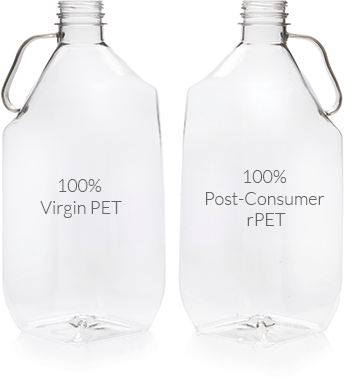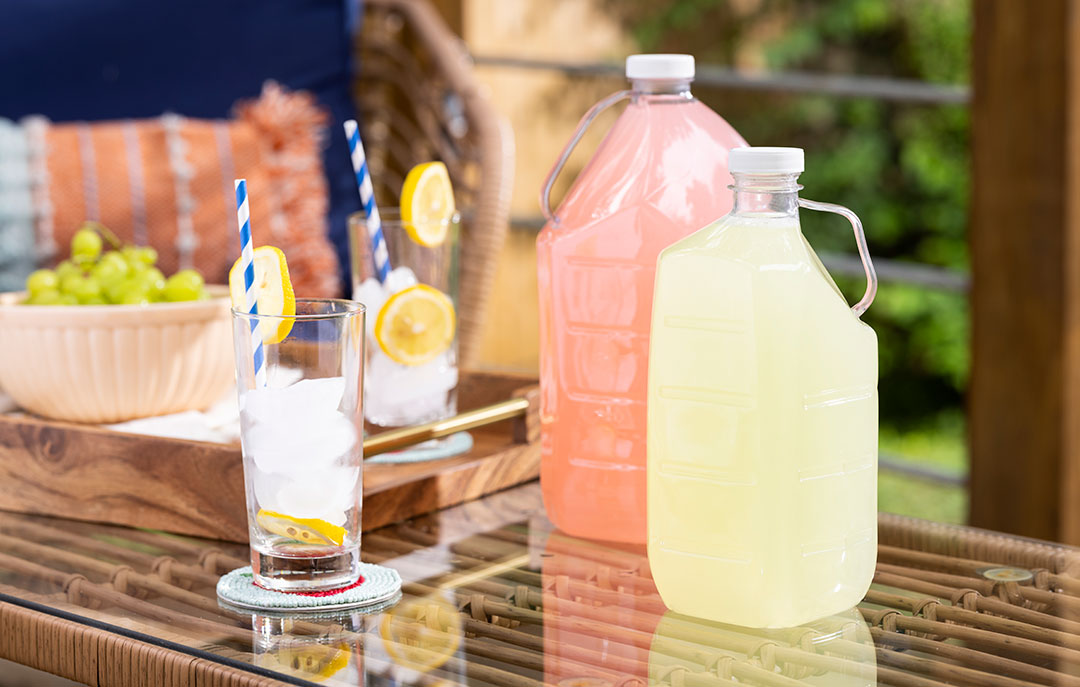Recently I’ve been asked about the use of post-consumer recycled plastic (PCR) in BottleOne PET containers. PCR is a subset of rPET, which is recycled PET. PCR comes from bottle recovery programs such as curbside recycling and bottle deposit channels. Here are my thoughts on the subject, live and raw, from the commercial rollout of BottleOne’s handle PET technology.
It seems like every few days we hear another CEO or Chairman of the Board of a CPG company stand in front of a group of shareholders and set bold goals of 25-in-25 or 50-in-30 or some other combination of numbers.
These proclamations refer to the percentage of post-consumer recycled plastic to be achieved in rigid packaging, and the year in which that level will be achieved. For example, a 25-in-25 pledge would be migration to 25% PCR in 2025. Making such public promises is visionary, essential leadership.
I believe these commitments are, in the aggregate, quite impossible to achieve in the United States… today. There is not enough PET being recovered to make good on all of the promises. For every promise kept, there will be two that are not, unless things change.
This is not to say, in any way, that these company leaders are insincere. On the contrary, these promises are intended to create a crisis that ripples through the supply chain and will ultimately enable attainment of all these bold goals. But first, we get the crisis.
When it comes to recycling, the U.S. does not have the social contract of places like Norway, Germany, or Japan. In those countries, the attitude toward waste and recycling is quite different by necessity.
There are also more practical reasons why the U.S. lags behind. Those countries, each with fantastically high recycling rates for PET, combine to equal about 11% of the U.S. land mass, so the infrastructure necessary to support recycling is smaller and much more efficient than it is here.
The bottom line is that in the U.S., we need to get better at recovery and reprocessing. Don’t think for a minute that the CEOs of these CPGs don’t know all about that bottom line.
The PCR promises, and the hopeless shortfall in PCR material, set off a cascade of events that is both entirely predictable and currently underway.
The crisis ends up first at the processor, who must bid up the price of the post-consumer recycled plastic at the material supplier. Right now, it is not unusual to see spot market PCR prices 60-90% higher than virgin material.
The principles of supply and demand are alive and well in the resin market, and nothing is more out of balance than post-consumer recycled plastic. The premium for PET PCR is not a bad thing, as it provides the financial justification for increased investment in collection, sorting and processing.

In the short term, it hurts the pocketbook. But in the long term, it provides the capital for greater scale and efficiency, as well as a stable supply. Already we are seeing significant investment from domestic providers on this arc, but pricing and supply relief is still a way off.
Capitalism, with a likely assist from regulatory authorities in the form of deposits, etc. will move the PET post-consumer recycled plastic supply crisis toward resolution. PET has a unique position among plastics because of its inherent circularity, and ability to return to food grade upon recycling.
Migration to PET started decades ago, and the final holdout applications will convert in short order. They must do so in order to meet enterprise goals and remain in regulatory compliance.
Other than being personally responsible for recycling the waste we generate, there is little we can do as individuals to resolve the material side of this equation other than buying PET (resin code 1) packaging and always recycling it. Some of these market shifts will need time to evolve.
At BottleOne, our customers are telling us they will not consider using any technology that is not compatible with their PCR % goals. Fortunately, BottleOne processes and equipment can handle any level of PCR.
We have run dairy half gallons at 50% and 100% PCR without issue, so there is high confidence that the changes necessary to run PCR are well within the scope of BottleOne technology.

The greater concern is the effect of post-consumer recycled plastic on processing larger (gallon) bottles with higher stretch ratios and bottle top load – and this impact on performance. Larger bottles have higher stretch ratios that might be more challenging with the use of PCR.
Also, it is normal to see some degradation in top load and impact performance as PCR percentages rise. We can process around some of that degradation, but the impact of PCR on a specific bottle’s performance will not be empirically determined until production sampling occurs.
BottleOne containers are designed to be caseless, and will enable elimination of most secondary packaging due to their inherent strength and durability. If PCR content negatively affects strength and durability, we will adapt designs and processes to mitigate them in order to keep secondary packaging minimized.
The door to circularity swings only one way, opening to the future, and it will not permit a return to the past. Post-consumer recycled plastic is here to stay.

Going forward, we will share our experience with BottleOne PCR containers. In the meantime, please reserve judgement on the 25-in-25 pledges.
They are attainable in PET, and attainable with BottleOne. We are in the middle of a PCR supply crisis, which bring increased costs. That will pass in time.
Application development is moving forward at a torrid pace, and post-consumer recycled plastic is an essential part of every discussion.
We have a dairy launch scheduled for the fall, and those bottles will have 25% PCR content. We have two other major applications that are in final development that will also contain PCR.
There is plenty to learn, and plenty of room to grow, when it comes to PCR in handle containers. I look forward to keeping you informed on our journey to circularity.
Thank you for your attention and continued interest in BottleOne.
Let us show you how BottleOne will help you reach your PCR goals
BottleOne is an affordable large capacity, standard grade PET bottle with an integrated PET handle. BottleOne is designed to dramatically impact your supply chain. Let us introduce you to this 21st century operating model.


0 Comments